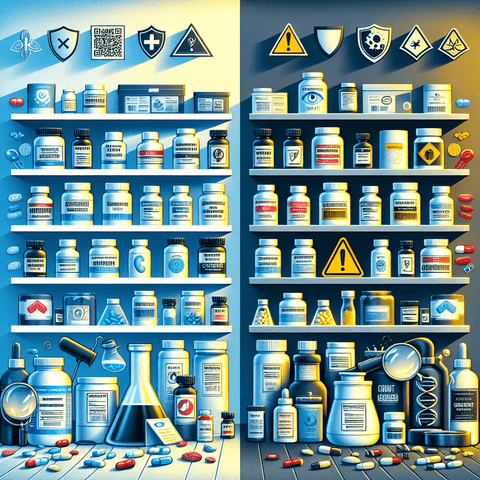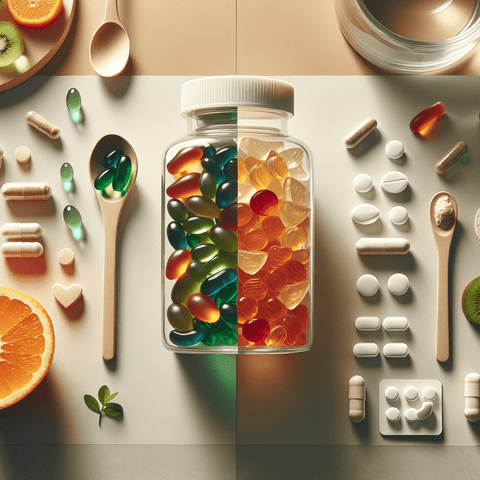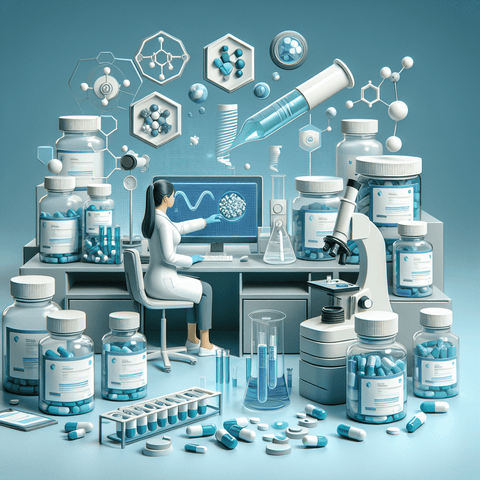Introduction: The Rise of Fake Supplements in the Nutritional Marketplace
The global nutritional supplement industry has experienced a remarkable trajectory over the past decade. Driven by an increasing awareness of preventive health, rising fitness culture, and an aging population interested in longevity, the market is valued in the hundreds of billions of euros and growing steadily. But with skyrocketing demand comes a darker shadow: the influx of counterfeit supplements.
In recent years, consumers have reported numerous cases of supplements that looked genuine but delivered no effects—or worse, caused adverse health reactions. Investigations around the globe have uncovered unauthorized nutrient products containing improper or hazardous ingredients, falsely labeled components, or diluted concentrations of active substances. These counterfeit supplements frequently mimic well-known brands, making them difficult to detect at first glance.
The implications of consuming fake nutritional supplements are serious. They go beyond financial loss. Taking these products may expose consumers to allergens, toxins, or interactions with medications. In the best-case scenario, a counterfeit product has no benefits; in the worst-case scenario, it causes harm.
The purpose of this blog post is crystal-clear: to provide you with practical, science-backed knowledge on how to identify, avoid, and verify the authenticity of the supplements you purchase—so you can make informed decisions and safeguard your health. Whether you're buying Vitamin C for immune support or Magnesium for bone strength and muscle function, know exactly what you are putting into your body.
Counterfeit Vitamins: Why Fake Nutritional Supplements Are Dangerous
Fake or counterfeit supplements can take on a number of deceptive forms—some more subtle than others. At their core, counterfeit supplements are unauthorized products that either misrepresent their contents or use falsified branding. These can include completely fabricated versions of genuine products, expired tablets repackaged as new, or capsules that contain little more than starch fillers labeled with false active ingredient amounts.
Several fake supplements incorporate altered or prohibited substances. For instance, some have been shown to contain amphetamines, steroids, or synthetic chemicals not permitted for use in food or dietary products under EU regulations. Others might use banned coloring agents or preservatives. Alarmingly, some even use active pharmaceutical ingredients (APIs) disguised under nutrient categories, posing significant drug interaction risks if consumed unknowingly alongside prescribed medications.
These counterfeit products pose credible health threats. Common risks include allergic reactions due to unlisted ingredients, digestive issues, hormonal disruptions, and even neurological symptoms. In countries with porous market regulations, such as parts of Asia, Africa, and even some regions in Europe, local health authorities have often reported seizures of these fake vitamins in large volumes—sometimes involving multinational distribution scams.
One real-world example includes a major counterfeit ring busted in 2021 in Eastern Europe, where over two tons of capsules marketed as high-potency Vitamin D were found to contain only corn starch and artificial dye. Another example saw online sellers in the UK arrested for repackaging expired Vitamin K supplements with new labels, despite the degradation of their potency and safety.
According to experts in toxicology and regulatory affairs, the rise of counterfeit nutritional supplements is a threat not just to individual consumers but also to public health systems. When people self-medicate with contaminated or ineffective products, it can delay genuine treatment, mask symptoms, or initiate a cascade of negative biological effects that take considerable time and resources to correct.
It is critical for consumers to understand the magnitude of the problem and to develop a discerning approach to supplement purchases through vigilance and proper education.
Supplement Authenticity: How to Ensure You’re Getting the Real Thing
Supplement authenticity refers to the assurance that a nutritional product is exactly what it claims to be in terms of its composition, concentration, origin, and shelf-life. This means the supplement contains the declared ingredients, from the specified source, in the specified amount, and has been handled and stored according to approved safety protocols.
Fortunately, numerous national and international regulatory bodies are engaged in overseeing the safety and authenticity of dietary supplements. In the European Union, the European Medicines Agency (EMA) dictates safety, marketing, and composition standards for specific classes of supplements. Additionally, EFSA (European Food Safety Authority) governs nutrition-related health claims and composition thresholds.
One of the most effective ways to judge authenticity is to look for third-party certification and testing seals. These may include:
- GMP (Good Manufacturing Practice): Certifies adherence to quality assurance protocols during production.
- USP (U.S. Pharmacopeia): Lab-verifies the identity, strength, purity, and performance of supplements.
- NSF International: A global health and safety certification body for food and supplements.
High-integrity retailers and recognized brands hold themselves to these standards and voluntarily submit their products for testing. At Topvitamine.com, for example, authenticity is upheld through partnerships with verified and regulated manufacturers. Consumers looking for Omega-3 fatty acid supplements like DHA/EPA fish oils should always seek out certification for contaminants and sustainability (e.g., IFOS or MSC-certified fish oil).
Another red flag lies in the distribution channel. Supplements purchased from unofficial channels, pop-up websites, or third-party resellers on e-commerce platforms are significantly more likely to be counterfeit. Always prioritize official websites or physical stores that transparently list contact information, manufacturing details, and refund policies. That assurance of traceability is a hallmark of a reputable supplier.
In summary, a careful review of certificate seals, purchasing channels, and manufacturing transparency is your first line of defense against deceitful products.
How to Spot Fake Supplements: Warning Signs of Counterfeit Products
Identifying fake supplements requires a keen eye and a cautious mindset. Often, counterfeit products exhibit small inconsistencies that might initially go unnoticed but eventually reveal themselves through packaging anomalies, inconsistent dosages, or product performance.
Here’s what to watch for:
- Packaging errors: Legitimate brands invest heavily in quality packaging. Watch for blurry or poorly printed labels, grammar mistakes, missing seals, or odd font spacing. A faded label could indicate prolonged exposure to sunlight or be a sign of repurposed packaging.
- Price discrepancies: If a premium supplement is listed at a steep discount (e.g., 70% off), be skeptical. Although sales occur, legitimate sellers rarely undercut standard pricing by such extremes. Always compare with the official store or known resellers.
- Website trust cues: Fraudulent sellers often use fake websites that mimic large brands. Look out for missing contact information, no return policy, broken copyright notices, lack of professional photography, and vague product descriptors.
- Smell, color, and consistency: Supplements—depending on form—should have uniform size, color, and a neutral, slightly medicinal odor (or none). An inconsistent appearance or foul smell can indicate degradation or substitution.
- Online platforms: If buying through peer-to-peer marketplaces like eBay or Amazon, examine the seller’s history, read detailed reviews, and check whether they're an “Authorized Reseller” of the brand. Look for buyer protection mechanisms to contest fakes.
Another solid tip is to check batch numbers or QR codes on the product label. Authentic products frequently feature scannable codes that link to manufacturing details or lab verification results—data that fakes cannot reproduce meaningfully.
Supplement Safety Tips: Smart Shopping Habits to Avoid Fake Products
Being a savvy supplement buyer doesn’t mean you need a chemistry degree—it simply necessitates a systematic and cautious buying approach. Here are foundational safety habits that reduce your exposure to counterfeit supplements:
- Check the expiration date and lot number. These two pieces of information are indicators of quality control. Reputable brands always print them visibly. A missing or smudged lot number is highly suspect.
- Buy directly from authorized vendors. Sites like Topvitamine.com maintain strict procurement policies, listing only verified and certified products from globally trusted manufacturers.
- Storage conditions matter. Even authentic supplements can degrade quickly if stored under improper conditions like high heat or direct sunlight. Good retailers store at controlled temperatures and account for product sensitivity when shipping.
- Use brand verification tools. Advanced supplement brands now offer QR codes or smartphone apps that verify packaging authenticity in real-time. Keep a record of scanned items and discrepancies.
- Maintain a supplement journal. When testing new supplements, record the name, brand, date started, and any noticeable changes. Cross-reference with your baseline health assessments. This helps catch abnormalities early, whether from fake or incompatible formulations.
In all these strategies, preservation of transparency and consistency is the key. Make sure to go through certifications on product pages before adding items—even well-known nutrients like Magnesium or Vitamin D. When in doubt, contact the retailer to confirm details rather than take risks.
Verifying Supplement Labels: Reading Ingredients & Certifications Like a Pro
Knowing how to read and interpret supplement labels puts you ahead of potential counterfeits. Manufacturers of authentic health supplements are bound by law to provide certain label components aligned with EU regulations.
Here are the essential components of a trustworthy label:
- Complete ingredient list: All active and non-active ingredients must be listed with corresponding quantities. Avoid vague terms like “herbal blend” or “energy complex” without dose amounts.
- Manufacturer information: Full legal name, address, and often, customer service contact details should appear. Many counterfeits omit these.
- Lot number and expiration date: This allows traceability in case of withdrawals or adverse effects reports.
- Certification symbols: Look for respected marks like USP, NSF, GMP, or equivalent European quality seals.
Cross-comparison of label values with EFSA nutrient databases is a good strategy as well. For example, if a product claims more than the Acceptable Upper Intake Level for Vitamin A or Calcium without clear necessity, it’s suspicious. Label claims like “all-natural,” “super strength,” or “proprietary detox formula” are unregulated and should be approached skeptically unless backed by clinical review or third-party testing.
Don’t forget allergen awareness either. Labels must disclose presence of soy, gluten, dairy, or shellfish depending on the product. Ideally, seek brands that actively test for contaminants through third-party partnerships.
Conclusion: Stay Vigilant and Stay Informed
In conclusion, the world of nutritional supplements promises many health advantages—but only if approached with diligence and discernment. Counterfeit supplements are not only ineffective, but they’re outright dangerous. However, through label literacy, smart purchasing habits, and a basic understanding of the regulatory landscape, you can proactively safeguard your health.
Stick with trusted vendors like Topvitamine.com, vet products for appropriate seals and certifications, and never hesitate to ask questions before confirming your purchase. Your body deserves real, effective nutrients—not risks masked in false labeling. And when in uncertainty, always consult a healthcare professional before starting new supplement regimens.
Q&A Section
How can I tell if a vitamin is fake?
Look for packaging inconsistencies, missing certification seals, strange smells or colors, and ultra-cheap pricing. Always check lot numbers and expiration dates.
What are the health risks of fake supplements?
Risks include allergic reactions, ineffective dosage, irreversible liver or kidney damage from toxic ingredients, and interactions with prescription medications.
Are supplements from Amazon and eBay safe?
Only if they're sold by verified retailers or manufacturers through official storefronts. Always read seller reviews, verify return policies, and be cautious of deep discounts.
Is “proprietary blend” a red flag?
It can be. Without knowing the quantity of each ingredient, it's hard to determine effectiveness or risk of overdose, so use caution and seek transparency.
Where is the safest place to buy supplements?
Official retailer websites like Topvitamine.com that partner with reliable brands and have clear policies, third-party certification, and batch verification are your best bet.
Important Keywords
- counterfeit supplements
- how to spot fake vitamins
- supplement authenticity
- buy safe supplements
- vitamin supplement safety
- how to check if a supplement is real
- trusted supplement retailers
- topvitamine.com supplements
- GMP-certified supplements
- third-party tested vitamins



